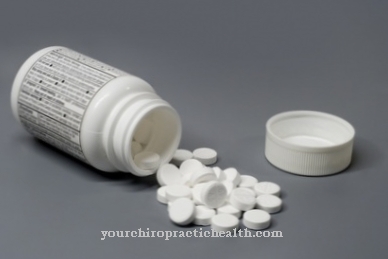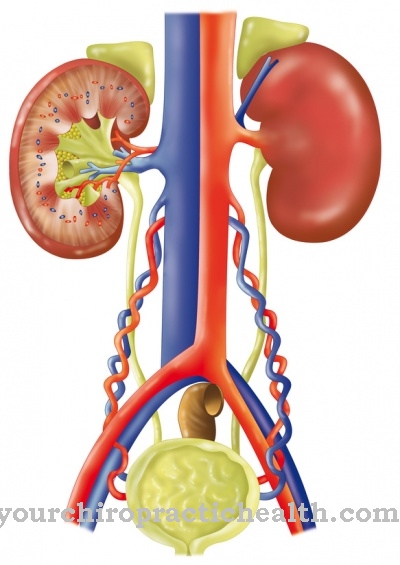Propranolol is a beta blocker. The agent is used to treat heart disease and high blood pressure.
What is Propranolol?

Propranolol belongs to the group of active substances called beta blockers. The drug has the property of lowering blood pressure. It also causes the heart rhythm to normalize.
Propranolol is one of the first beta blockers. The substance was developed in the early 1960s by the British pharmacologist and Nobel Prize in Medicine, James Whyte Black (1924-2010). The drug finally came onto the market in 1964.
Because propranolol lowers the heart rate and counteracts physiological tremors, the active ingredient is sometimes used as a doping agent, which is particularly true for shooting sports. Propranolol has been on the list of essential drugs of the WHO (World Health Organization) since 1990.
Pharmacological effect
Propranolol is counted among the beta-blockers. Therefore, the drug has the ability to influence the autonomic nervous system. This is responsible for controlling heart activity and blood pressure.
These two functions are regulated by special neurotransmitters (nerve messenger substances), one of which is primarily adrenaline. This hormone is produced within the adrenal medulla and has the property of binding to beta receptors, which are special docking points. This will give a signal that your heart will beat faster.
The beta blocker propranolol competes with adrenaline for beta receptors close to the heart. Ultimately, it ensures that the neurotransmitter is displaced so that the adrenaline is no longer able to increase the heartbeat. As a result, the heartbeat slows down and the blood pressure drops. The heart also reduces its consumption of oxygen.
As a fat-soluble, non-selective beta blocker, propranolol has the property of exerting its effect on beta-1 receptors and beta-2 receptors. To lower blood pressure, the drug has a dampening effect on the release of the hormone renin, which has a blood pressure-increasing effect, on the beta-1 receptors of the kidneys.
The blood vessels have both beta-1 and beta-2 receptors. This allows propranolol to narrow the diameter of the vessels. In the case of a migraine, for example, in which the blood vessels dilate too much, the special effect of propranolol can restore them to normal levels.
The absorption of propranolol into the intestine occurs relatively quickly and almost completely. However, two thirds of the active ingredient are broken down in the liver before they can be distributed within the organism via the bloodstream. After being metabolized in the liver, most of the propranolol is eliminated from the body through the kidneys. If the patient suffers from functional disorders of the liver or kidneys, the substance can have a longer effect, which in turn requires an adjustment of the dosage.
Medical application & use
Propranolol is one of the most important drugs for the therapy of cardiovascular diseases. The active ingredient is mainly used for arterial hypertension (too high blood pressure), coronary artery disease (CHD), attack-like pain in the chest region such as angina pectoris and for functional cardiovascular problems that are not organically caused, such as increased blood pressure or accelerated cardiac activity. The beta blocker also serves to prevent another heart attack.
In addition to the treatment of cardiovascular diseases, propranolol is also suitable for preventing migraine attacks and counteracting severe tremors, the causes of which are unknown. It can also be used to support the treatment of hyperthyroidism (overactive thyroid gland) or to alleviate simple anxiety states such as fear of exams or stress.
Propranolol is usually administered in the form of tablets. The dose level varies from person to person and is determined by the attending physician. In some patients it can also be useful to give the beta blocker intravenously. The doctor injects the drug directly into a vein.
Risks & side effects
In some patients, the use of propranolol has undesirable side effects. In most cases, these are headaches, drowsiness, tiredness, nervousness, dizziness, sleep disorders, sweating, abnormal sensations, diarrhea, constipation, nausea, vomiting, cardiac conduction disorders, drop in blood pressure, skin reactions such as redness and itching.
Even hair loss, nightmares, depression, or hallucinations are possible. Occasionally, dry mouth, bleeding in the skin, changes in the blood count, muscle weakness and breathing difficulties may also occur.
In the event of hypersensitivity to propranolol or other beta blockers, if the blood pressure is too low or if the heartbeat slows down, the drug must not be taken. The same applies if the patient suffers from bronchial asthma, diseases of the cardiac conduction system, cardiovascular shock or pronounced circulatory disorders in the limbs. Particular caution when using the agent is also advisable after prolonged fasting, in the case of diabetes mellitus or strong fluctuations in blood sugar levels.
Propranolol should only be taken during pregnancy if the state of health of the pregnant woman absolutely requires it. So there is a risk of premature labor or growth retardation in the baby. Since the drug is excreted in breast milk, it is recommended that the infant be monitored by a doctor while breastfeeding. Doctors advise against using the beta blocker in children.
Interactions with other drugs that are administered at the same time as propranolol are also conceivable. The effect of insulin or other diabetes drugs is increased by the beta blocker.
Simultaneous use of propranolol and MAO inhibitors for depression should be avoided altogether. Calcium antagonists such as diltiazem, antiarrhythmics, antihypertensive agents such as clonidine, adrenaline, cardiac glycosides and anesthetics also have a negative effect on the drug.



























